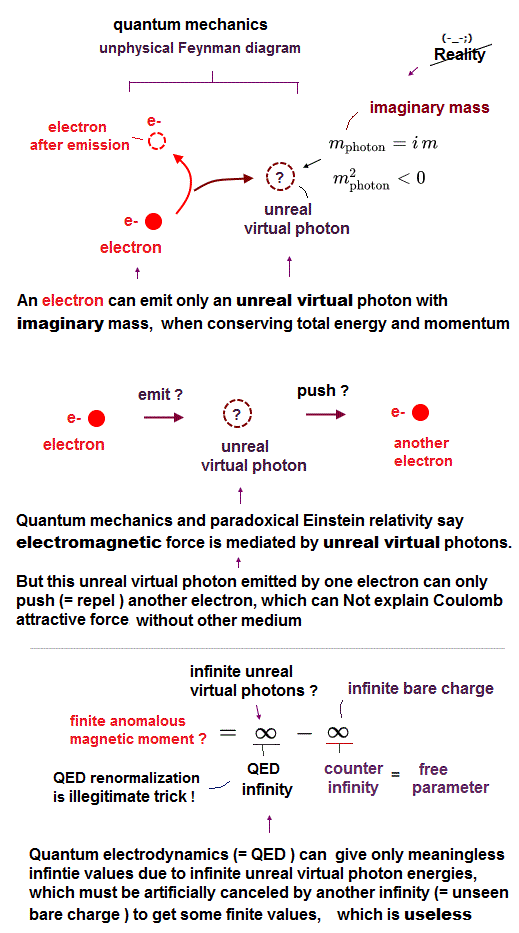
Home page
Quantum field theory is unreal
QED is wrong
(Fig.1) Electric force is generated by emitting virtual photons ?

The current quantum theory uses unreal virtual particles as force mediator and particle physics.
This virtual particles can have "imaginary mass (m2 < 0)", disobeying Einstein mc2, which cannot be observed as real particle ( this p.5, this p.6 ).
Forces such as electromagnetic are real, but they are caused by unreal virtual particles ? This is why the current physics or quantum electrodynamics (= QED ) is wrong, and must be replaced by real one.
(Fig.2) A moving electron emits a (virtual) photon and stops, conserving total momentum (= p ) and energy (= E ).
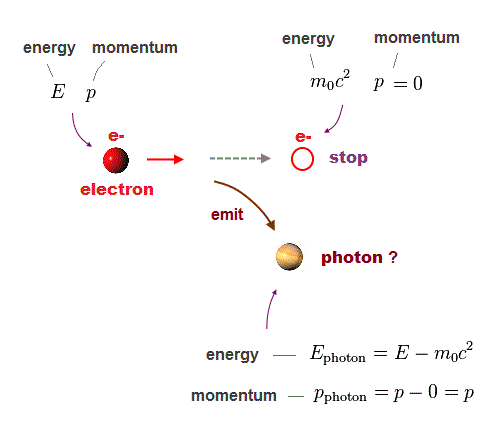
When an electron emits a photon (= light particle ? ), this photon always must be virtual (= Not real ) with imaginary mass ( m2 < 0 ) !
In all reactions, total energy (= E ) and momentum (= p ) must be conserved.
The initial energy and momentum of an electron are E and p, respectively. This electron stops after emitting a photon.
According to Einstein mass relation, the energy of the stationary electron is rest mass energy (= m0c2 ), and its momentum is zero.
Due to conservation law, the energy and momentum of the emitted photon is E - m0c2, and p, respectively.
(Fig.3) ↓ Einstein relativistic relation.
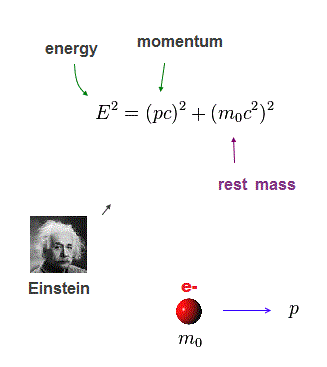
According to Einstein relativity, all ( real ) particles have to obey his energy-momentum-mass relation.
E, p and m0 are each particle's energy, momentum and rest mass, respectively.
(Fig.4) Photon with negative mass squared is virtual, NOT real.
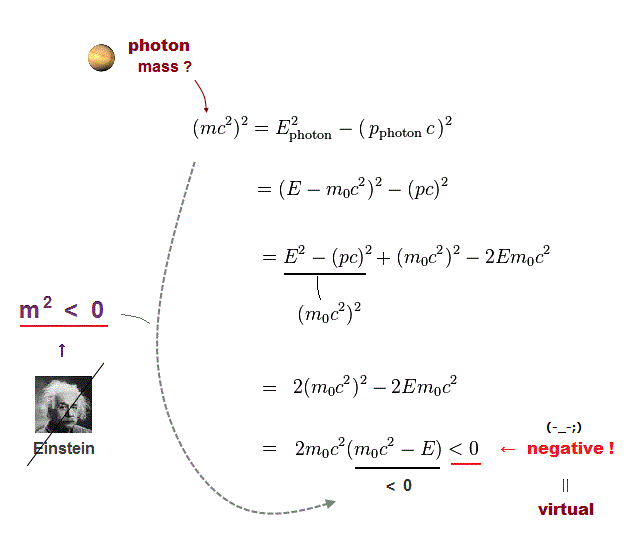
Inserting the energy and momentum of the emitted photon into Einstein's relation, you'll easily find this emitted photon has unreal mass whose mass squared is negative (= a virtual photon's m2 < 0 ), which means this virtual photon has an unreal imaginary mass.
In Fig.4, rest mass energy (= m0c2 ) is always smaller than total energy (= E = the sum of rest mass and kinetic energies ), so the final result is negative.
So when a photon emitted from an electron conserves total energy and momentum, its mass squared becomes negative (= imaginary mass ) and unreal.
In Einstein relativistic theory, all observers see this same imaginary mass of a virtual photon, though the imaginary mass itself is unobservable.
It means a photon model in quantum field theory fails due to these contradictory virtual photons with unreal masses, and we have to consider other realistic wave model involving the "whole atom" and medium.
(Fig.5) ↓ A neutron consists of a proton and an electron, Not quarks !
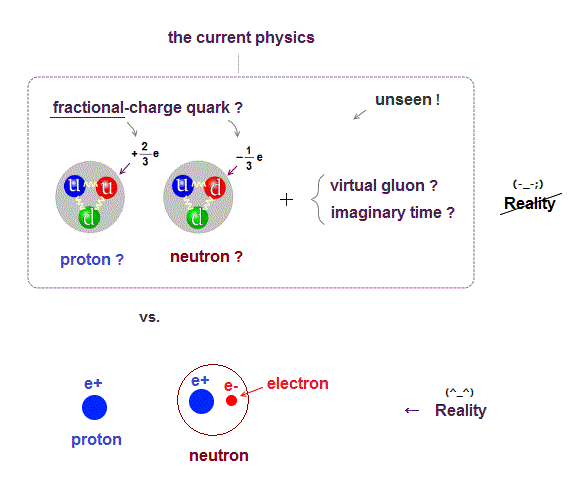
The current physics says a proton and a neutron consist of fractional-charge quarks, which can Not be separated or detected.
They insist a nucleus is filled with unreal virtual sea quark-gluon, and governed by imaginary time and extradimension.
The fact of neutron decay tells us each neutron simply consists of a proton and an electron, Not unseen quarks.
The current nuclear physics lacks reality, full of imaginary concepts and artificial adjustable parameters ( this p.5 ), so useless and prevents nuclear fusion research.
(Fig.6) ↓ The current physics uses unreal virtual W boson.
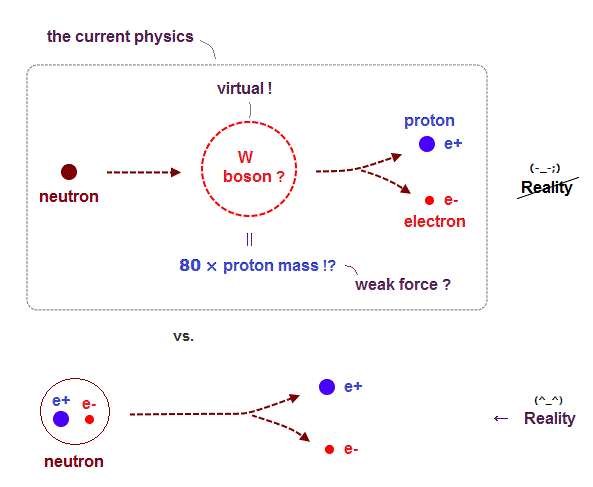
A neutron decays into a proton and electron in beta decay.
The current unphysical physics insists imaginary quarks inside neutron decays into virtual Weak boson, which is 80 times heavier than a proton ( or a neutron ) ! ← lacking reality.
It is impossible that a neutron emits weak boson, which is much heavier than a neutron itself, so they call it unreal virtual particle.
We don't need these contradictory, unreal, useless particles or artificial models.
We can simply say a neutron decays into a proton and an electron !
(Fig.7) ↓ The current nuclear model is full of unreal concepts.
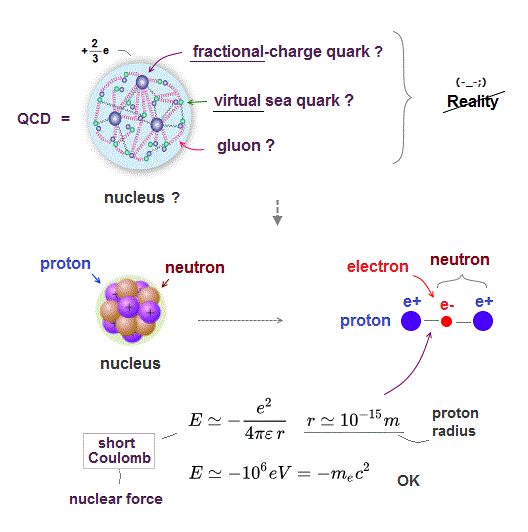
The current nuclear model is full of imaginary concepts, such as unseen fractional-charge quark, virtual sea quark-gluon ..
But these virtual quarks or fractional charges can never be observed, so we do Not need them.
Nuclei always consist of protons and neutrons.
There are No helium-2 whose nucleus consists only of two protons nor lithium-3 whose nucleus consists only of three protons.
As protons increase inside nuclei, neutrons increase, too. A neutron consisting of a proton and an electron is always necessary to form nuclei.
The current physics completely ignores these electrons inside nuclei, and forces only on imaginary virtual particles.
Electrons very close to protons inside small nuclei can exert strong attractive force.
From the proton radius (= 10-15 m ), we can estimate Coulomb energy between an electron and a proton inside nuclei, which is very big.
This short-distance Coulomb energy becomes about 1 MeV (= 106 eV ), which is almost as big as the electron's mass energy (= mc2 )
So, we can say strong nuclear force is caused by Coulomb force between a proton and a electron inside neutron, instead of imaginary quark- gluon with unobservable fractional change that is unnecessary.
We need to explain nuclear binding force by using only real electrons (= inside neutrons ) and protons that are experimentally observable in contrast to the imaginary unobservable fractional-charge quarks.
(Fig.8) ↓ Helium-2 whose nucleus consists only of two protons without electrons does Not exist, which shows nuclear binding force is short-distance Coulomb force between electros inside neutrons and protons.
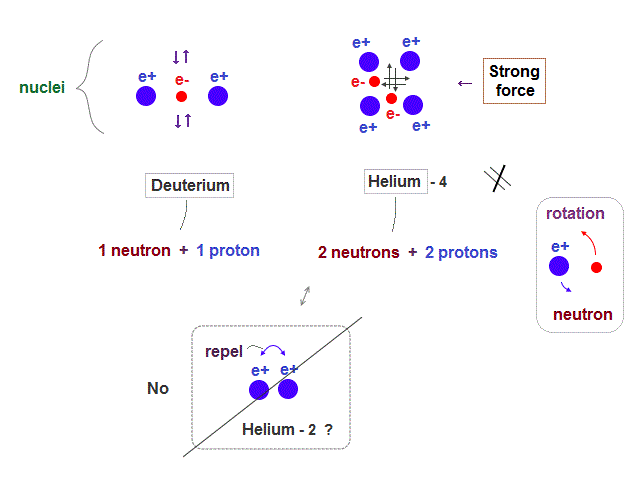
In Helium isotope, there are only Helium-3 and Helium-4. ← Both of these He-3 and He-4 nuclei contain electrons as a form of neutrons (= each neutron consists of a proton and an electron ).
Helium-2's nucleus consisting only of two protons without neutrons or electrons cannot exist.
This fact proves that electrons inside nuclei act as "adhesive" among protons inside nuclei.
The fact that electrons are also major components of nuclei can be confirmed from observing nuclei absorbing electrons (= electron capture ) or nuclei emitting electrons (= beta minus decay ).
Nuclei include more protons than electrons, so electrons are oscillating among protons, instead of rotating around protons.
When there is only a pair of an electron and a proton like in neutron, the electron tends to rotate around the proton, become a hydrogen where the electron's orbital is stable, when its length is an integer times de Broglie wavelength.
(Fig.8') ↓ True Coulomb nuclear force can explain why Helium-2 cannot exist, and Helium-4 is the most stable and abundant.
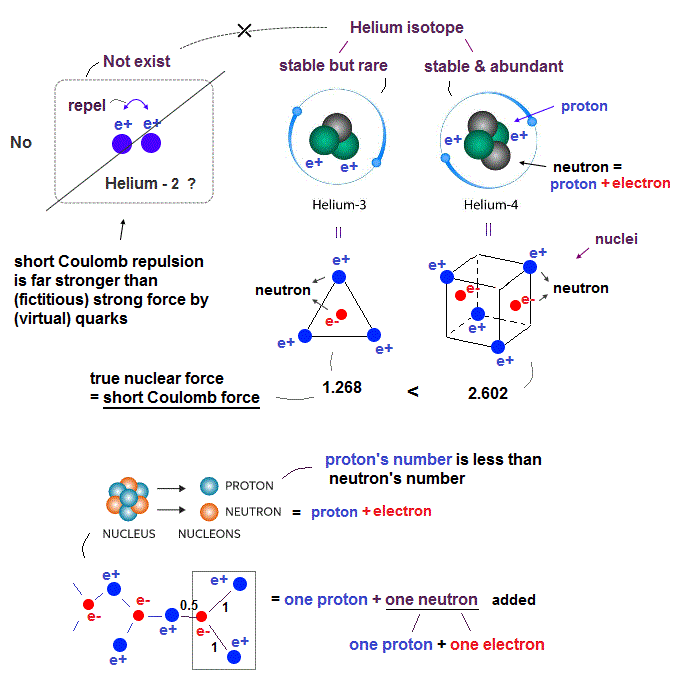
If the current mainstream (fictional) particle physics is true, Helium-2 whose nucleus is composed only of two protons or diproton, must exist stably.
But this Helium-2 cannot exist, because Helium-2's nucleus consists only of two positive protons, and strong Coulomb repulsion between these two protons prevents Helium-2 formation.
↑ This means the (fictitious) strong force through imaginary unseen fractional-charge quarks and (virtual) gluons is weaker than short-distance Coulomb force, even if such a strong force via (fictional) quarks existed.
So the fictitious quantum mechanical strong force allegedly via virtual quarks and gluons is meaningless (= less influential, even if it existed ), and only realistic Coulomb force can exert strong decisive repulsion and attraction also inside nuclei.
It is known that atomic nuclei consist of protons and neutrons where the number of protons is equal to or less than the number of neutrons.
A neutral neutron consists of one positive proton and one negative electron, so this negative electron inside a neutron works as adhesive between repulsive positive protons through short-distance Coulomb attraction between positive protons and negative electrons.
This short-distance Coulomb force used as true nuclear force can explain why Helium-2 (and Lithium-3's nucleus with three protons ) cannot exist due to lack of negative electrons (= adhesive ) between two or three protons.
In Helium isotope, Helium-4, whose nucleus consists of two protons and two neutrons (= which are equal to four protons and two electrons, because each neutron consists of one proton and one electron ), is known to be the most stable and abundant.
Helium-3, whose nucleus consists of two protons and one neutron (= which are equal to three protons and one electron ), is also stable but far less abundant than Helium-4, because its (short-distance) Coulomb attraction is about two times weaker than the Helium-4's Coulomb attraction (= the above figure numbers such as 1.268 < 2.602 means the ratio of the strengths of short-distance Coulomb nuclear attraction between Helium-3 and Helium-4 ).
It is known that each atomic nucleus consists of almost same number of protons and neutrons.
One proton and one neutron ( a neutron = proton + electron ) are equal to two protons and one electron.
As shown in the above figure-lower, we show that it is possible to add one proton + one neutron (= equal to two protons + one electron ) to the rest particles of each nucleus consisting of an arbitrary number of protons and neutrons, obeying Coulomb attraction (= in the upper figure, the distance between a new electron and an already-existing proton is supposed to be a half of the distance between a new electron and new protons ).
As a result, we can also explain why atomic nuclei consist of almost the same numbers of protons and neutrons using the realistic short-distance Coulomb force replacing fictitious meaningless strong force via virtual quarks and gluons.
As I said, if each nucleus contains the same numbers of protons and electrons (= which means this nucleus consists only of neutrons without protons = excessive neutrons ), each electron cannot stay between two protons (= because the number of electrons increases to the same number of protons ), and some electrons tend to rotate around the positive protons (= remain as a part of nucleus with the remaining less electrons or neutrons ).
↑ Like the ordinary atomic orbits, the electron de Broglie wave interference (= orbital length cannot be shorter than an integer number 1 × de Broglie wavelength to avoid destructive interference of de Broglie wave ) prevents some electrons from returning to the initial very small area between protons inside nuclei, hence, nuclei always become positive Not neutral.
↑ This de Broglie wave (destructive) interference of an electron rotating around the proton can explain why a neutron is unstable, separating an electron from a proton to become a hydrogen atom.
So the realistic short-distance Coulomb force and de Broglie wave nature can perfectly explain why the number of protons is almost equal to (= or slightly less than ) the number of neutrons inside each nucleus.
(Fig.9) ↓ Electron emits light in the "transverse" direction.
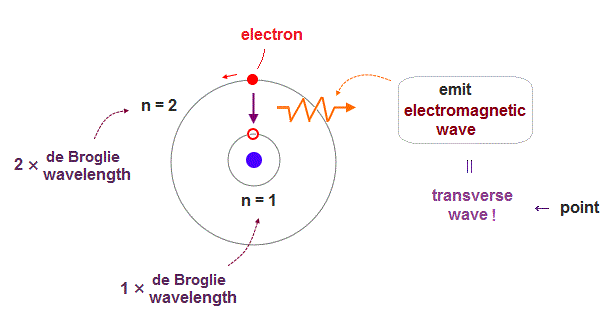
According to the present unphysical quantum mechanics and QED, an electron can emit or absorb only an unreal virtual photon with imaginary mass, violating Einstein relativistic energy-mass relation, when the total energy and momentum are conserved ( this-p.10, this-p.15 ).
↑ We can avoid this unreal virtual photon, if we use classical light wave.
When the excited electron of the higher energy level of n = 2 returns to the lowest-energy ground state of n = 1 energy level, the electron's de Broglie wave energy (= stored in the medium around the electron ) is emitted as light wave whose transverse oscillation stores part of initial electron's de Broglie wave energy.
↑ The total momentum combining the electron and nucleus is almost unchanged (= in the periodic circular motion ), which can emit real light wave with large energy and smaller momentum ( this-5-6th-paragraphs ) by conserving the total energy and momentum.
So instead of the unphysical quantum mechanical electron emitting unreal virtual photon, the medium around the electron and the proton generates the real light wave from the electron's de Broglie wave.
(Fig.10) ↓ Electromagnetic light wave emitted from the orbiting electron is a transverse and longitudinal oscillating wave whose wave phase velocity is the constant light speed c, and the light energy is proportional to frequency f satisfying photoelectric effect.
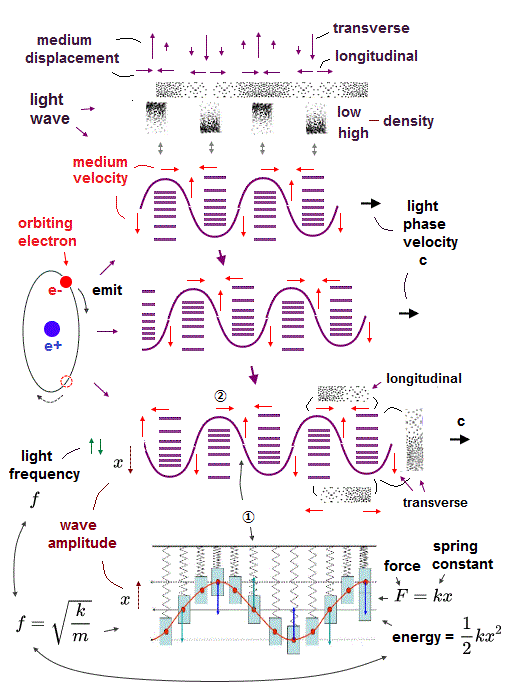
Contrary to the ordinary explanation, classical realistic light wave can naturally explain photoelectric effect where an electron can emit or absorb the light wave.
The present quantum mechanics and QED has to rely on unreal virtual photons with imaginary mass interacting with electrons in photoelectric effect.
In photoelectric effect, the light energy proportional to light frequency is absorbed into or emitted from an electron (= frequency = c/wavelength means light is wave, Not a photon particle ).
↑ This light energy proportional to frequency can be naturally explained by classical light wave interacting with electron's de Broglie wave whose kinetic energy is related to frequency.
Electromagnetic wave can be considered as wave mixing transverse and longitudinal waves. ← The transverse oscillating energy is absorbed into or emitted from electron's de Broglie wave oscillating in the same direction as the light's transverse oscillation.
We can compare the light wave oscillation (in the light medium ) with the oscillating spring whose spring constant is k.
↑ The spring energy is expressed as 1/2kx2 related to both (light's medium's) frequency f (= related to spring constant k ) and the (light medium's) amplitude x.
If we assume this spring's energy 1/2kx2 equals the light's energy 1/2εE2 where E is the electric field, ε is the electric constant, we can say the electric field E is proportional to the (light medium's) displacement x × square root of k (= spring constant k is related to how steep the light's medium's density gradient is ).
↑ Electric force is equal to the electric field E (= x × square root of k ) × charge (= space derivative of the electric field E = square root of k ), which is compatible with electric force = kx (= spring force ).
So the magnetic field can be considered as the spring or the light's medium's kinetic energy (= time derivative of the electric field E equal to magnetic field ) compared with the electric field E related to the light medium's displacement x (and the medium's density gradient k ).
As a result, in the photoelectric effect, the light medium's frequency f needs to surpass some threshold to excite the electron's de Broglie wave, which can be perfectly explained by the realistic classical light wave.
We often see the (false) explanation that if light is wave. it takes longer time for an electron to absorb energy enough to be ejected from a atom than the case where light is a photon particle in photoelectric effect ( this-4th~5th-paragarphs ).
But actually, electrons in atoms are constantly absorbing various light energies even without the light souce ( this-p.2 ).
And electron's de Broglie wave interacting with light spreads over larger area than a single atom, as seen in de Broglie wave interference, which can explain electron's de Broglie wave absorbing light spreading over large area in short time.
Even in the very weak light source, each light is emitted from a single atom, so some small light wave packet emitted from an atom inside weak light can instantly eject an electron in another atom in photoelectric effect.
As a result, classical light wave can perfectly explain photoelectric effect even without quantum mechanical unreal (virtual) photons.
(Fig.11) Why "neutrino" and "light" always travel at light-speed c ?
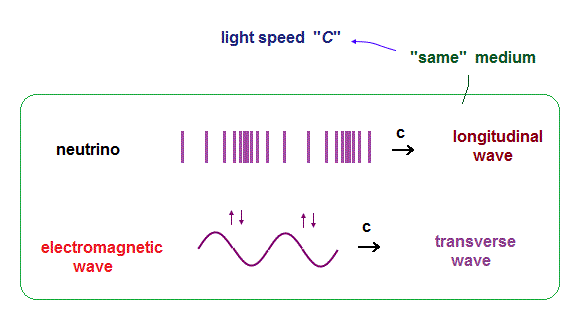
It is known both neutrino and electromagnetic wave always travel at light-speed c.
"Constant" speed means these things are some oscillations travelling in the same common medium.
We can naturally think that this neutrino is longitudinal wave (= because the neutrino is basically emitted from nuclear reaction, not from atomic electrons periodically orbiting around nuclei ), the light is "transverse (= complex )" wave travelling through the common medium with the light speed.
If the neutrino is longitudinal wave, it doesn't interact with electron's orbit in the transverse direction, which can explain why "neutrino wave" can pass through things like ghost.
(Fig.12) light energy = h × frequency f.
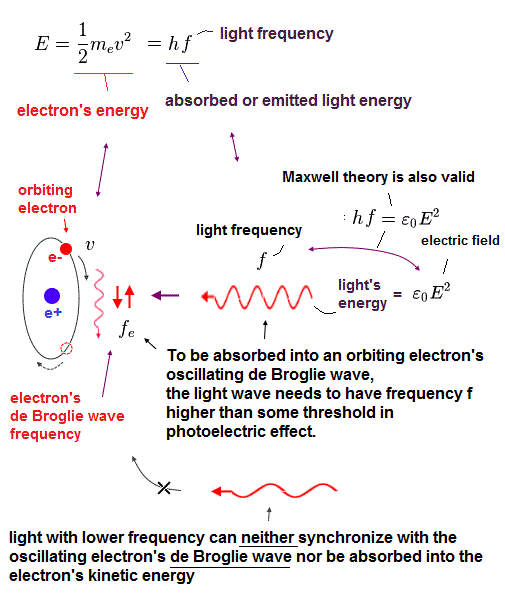
The realistic classical light wave can naturally explain the photoelectric effect showing the light emitted from atom has the energy of hf ( h is Planck constant, f is light frequency ).
We suppose an electron's de Broglie wave storing the electron's kinetic energy of 1/2mev2 ( me and v are electron's mass and velocity. ) emits light.
( To be correct, the whole atom of electron and nucleus emits the light or electromagnetic wave by pushing the medium around them, avoiding the contradictory QED virtual photon allegedly emitted from the inside of an electron, the nuclear kinetic energy is so small that it can be neglected ).
(Fig.13) de Broglie wavelength (= λ ) = h/p, p is momentum
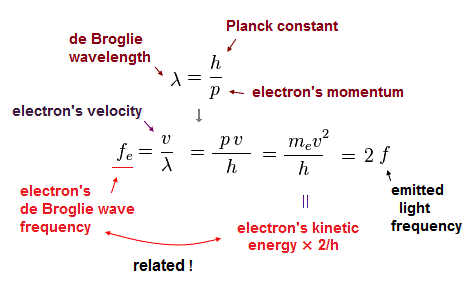
According to wave relation, frequency f is equal to velocity (= v ) divided by wavelength ( λ ).
When an electron is moving at a velocity of v, its de Broglie wavelength becomes λ = h/mv = h/p ( p is electron's momentum ).
From Fig.12 and Fig.13, we get the relation of electron's de Broglie wave frequency (= fe ) equal to the electron's kinetic energy × 2/h (= mv2/h ), which is twice the emitted light frequency (= 2f ).
↑ As shown here, the electron's kinetic energy is proportional to its de Broglie wave's frequency (= fe ), which is why the energy of the light interacting with the electron (= de Broglie wave ) must be related to the light frequency in addition to the light intensity in photoelectric effect.
Electron's de Broglie wave is known to spread over large area like light wave as shown in experiments of de Broglie wave's interference and diffraction, which can also perfectly explain why spreading light wave can interact with electron's de Broglie wave in light's absorption and emission.
(Fig.14) Oscillating electron emits light and gradually loses its energy.
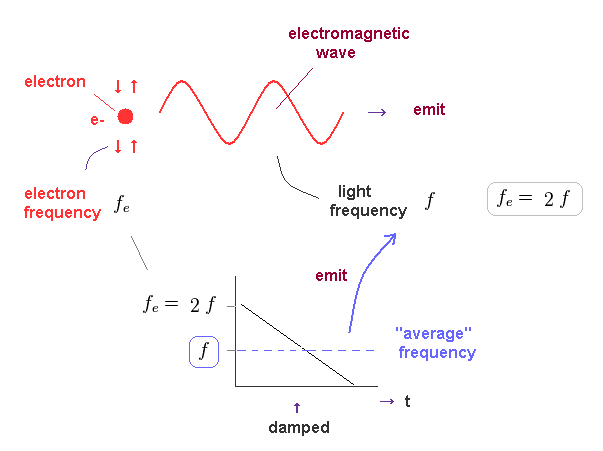
We think about the case in which oscillating electron gradually emits light and loses its kinetic energy.
The initial electron's frequency is equivalent to 2 × f (= emitted light frequency ), as shown in Fig.13.
The more light the electron emits, it loses more energy, and its oscillation becomes slower ( to be zero ).
It means the average electron's frequency becomes half of the original value (= 1/2 × fe = f ) .
As a result, we can prove there is an important relation between electron's and emitted light frequencies (= the emitted light frequency f is equal to the electron's de Broglie wave energy's average frequency, f = fe ). Planck constant (= h ) connects light and electron.
This is the mechanism of photoelectric effect using "real" light and electron.
(Fig.15) Imbalance in "field pressure" causes plus, minus charges.
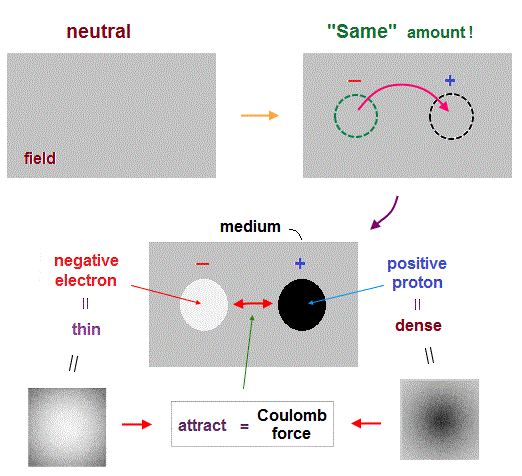
Quantum mechanics cannot answer "why the universe contains exactly the same amount of plus, minus charges" as protons and electrons. And they have NO definite answer, "why a proton is much heavier than an electron".
If we suppose Coulomb force is caused by the difference in field pressures (= density ), we can naturally answer all these basic questions.
In Fig.15 upper, some amount of field matters are transferred to another places.
This causes a pair of "thin" area with lower pressure, and "dense" area with "higher" pressure in the field (= medium ).
If the field matters are unevenly distributed, they try to go back to the uniform density, which is the origin of Coulomb attraction. "Denser" proton (= attracted to lower-density electron ) is naturally heavier than "thin" electron.
Due to pressure balance, the combinations of "dense-dense (= +, + )" and "thin-thin (= -, - )" areas repel each other, which is why the same charges repel each other in Coulomb forces.
(Fig.15') An proton is 1840 times heavier (= denser ) than an electron.
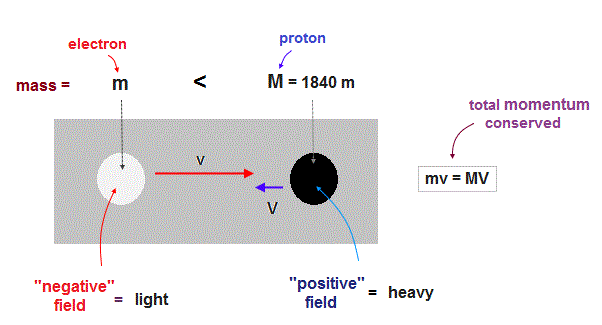
It is known that a proton is about 1840 times heavier than a electron. If we suppose, a proton (= positive field ) is 1840 times denser in the medium than an electron (= negative field ), this big difference in mass can be explained.
Due to imbalance in field (= medium ) densities (= "positive" is dense, "negative" is thin ), the opposite charges attract and start to move towards each other.
Total momentum ( and center of mass ) must be conserved due to the law of action and reaction.
So a "light" electron must move much ( 1840 × ) faster than a heavy proton during the same time.
(Fig.15') Einstein relativity deniying the medium can Not explain mass defect by potential enregy.
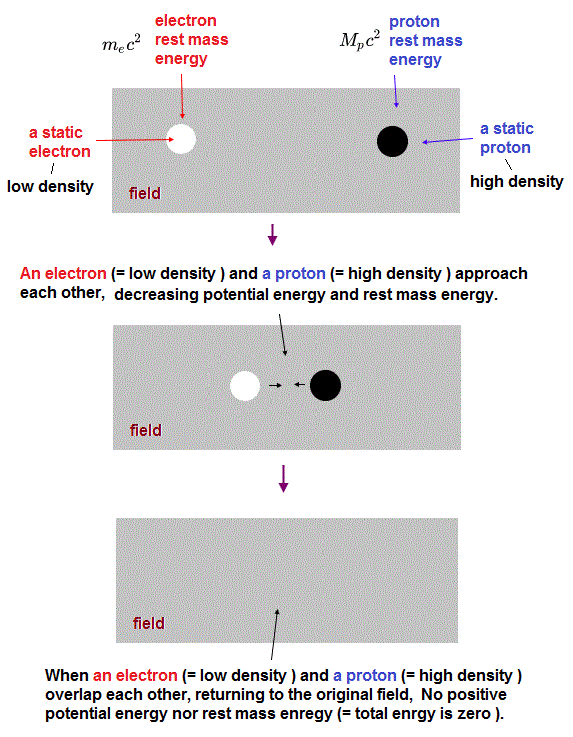
The present paradoxical Einstein relativity ignoring the medium and unphysical quantum field theory based on unreal virtual photons are unable to explain the rest mass defect in nuclear potential energy.
This realistic Coulomb electric charge caused by the medium's density difference can naturally explain this rest mass energy defect in nuclear or Coulomb attractive binding energy.
As shown in Fig.15', when an initial static electron and a proton attract and approach each other, it lowers the potential energy (= the medium's density imbalance decreases ), and decreases the total (relativistic) mass energy (= Maxwell's mc2 ), while the electron's and proton's relativistic mass related to kinetic energy paradoxically increases.
In the realistic Coulomb electric charge model, the negative electron closer to the positive proton decreases the imbalance in the medium's density, which decreases the resistance and the total mass (= resistance against the medium ) energy naturally.
When an electron completely overlaps a proton, the medium density imbalance is completely gone (= but particles' kinetic energy is left, so charges are stable ), which means zero rest mass energy (= the original medium state ).
(Fig.15'') the potential energy of medium imbalance (= electric charge ) is conserved.
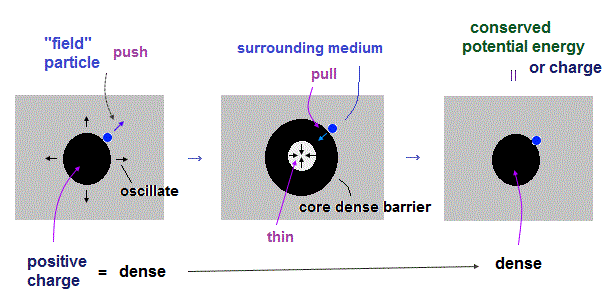
The reason why only the definite elementary charge value (= -e or +e ) is allowed is thought to be due to the property of the medium (= field ).
The stable conservation of the electric charge (= medium density difference ) needs the enough amount of medium's density imbalance.
Each charge whose potential energy s stored as the medium's density difference is regularly oscillating outwardly and inwardly like the oscillating spring.
So the medium's density difference or imbalance is stably kept as the oscillating energy, which can explain why Coulomb electric charges are stable.
If the amount of the charge (= medium density difference ) is smaller than e, the surrounding medium can easily enter and break the core medium's barrier (= smaller charge ) during this oscillation.
If the amount of charge is larger than e, no more surrounding medium can join the already-maximum-dense core medium (= charge ), hence, the charge cannot be bigger than e.
(Fig.17) ↓ Electric current I (= positive charges are moving and negative charges are at rest ) generates magnetic field B that exerts Lorentz magnetic force F on an external positive charge (= e+ ) moving at a velocity v
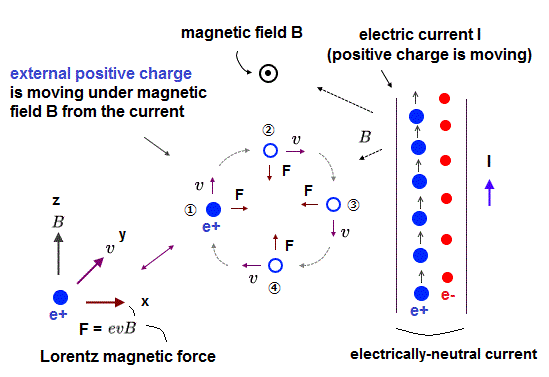
In the realistic world, there is No magnetic charge or monopole, hence, magnetic field B or magnetic force is related to the electric force, when charges are moving.
In the upper figure, positive charges (= +e ) are moving upward (= negative charges e- are supposed to be at rest ) as the electric current I.
This electric current I generates magnetic field B that causes Lorentz magnetic force on an external positive charge (= e+ ) moving at velocity v.
↑ This external positive charge is moving in circular orbit under magnetic field at constant velocity v.
We can explain the realistic mechanism of this ordinary magnetic field B and Lorentz magnetic force by using the real medium.
(Fig.17') ↓ Real mechanism of Lorentz magnetic force.
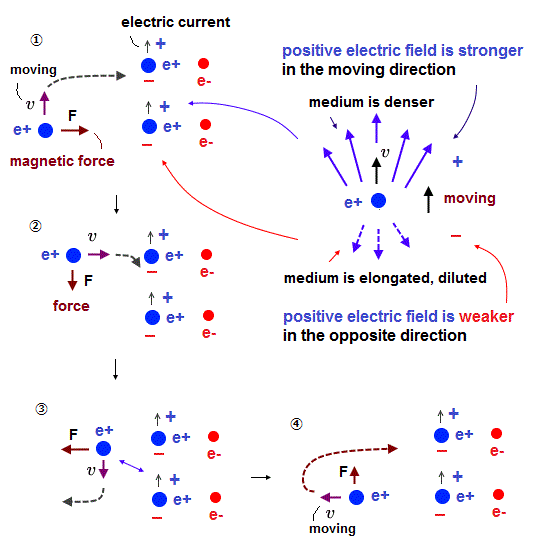
Here we explain realistic mechanism of Lorentz magnetic force without using unreal virtual photons of the current unphysical mainstream quantum field theory.
The electric field caused by the electric charge can be realistically explained using the medium's density difference.
When a positive charge (= +e ) is moving, the positive electric field in the moving direction (= front region ) tends to be stronger due to the denser medium pushed by the moving charge, while the positive electric field in the opposite direction (= back region ) becomes weaker due to the diluted, elongated medium caused by the charge moving away.
When an external positive charge (= e+ ) is moving upward at a velocity v (= ① ) at the left side of the electric current (= current direction is also upward ), this positive charge tends to be attracted to the back part with weaker positive electric field of the current charges (= attracted toward the current by Lorentz magnetic force F ) and be moving away from the stronger positive electric field region (= the front part of the current moving charges ).
↑ But of course, the average electric current is electrically-neutral (= consisting of the same amount of positive protons and negative electrons ), hence, the external positive charge can neither be accelerated nor increase kinetic energy, hence, this Lorentz magnetic force perpendicular to the moving direction of the charge cannot be exerted on the charge in the moving direction or accelerate it due to energy conservation law.
When the external positive charge is moving toward the electric current, this positive charge tends to be attracted toward the weaker positive electric field by turning downward (= ② ).
When this external charge is moving downward, it tends to crash into the stronger positive electric field of the front region of the current charges approaching, hence, this external charge tends to be moving away from the current (= ③ ) by Lorentz magnetic force.
When this external charge is moving away from the current, again, it tries to go after the weaker positive electric field of the back part of the electric current's charges and move away from the stronger electric field of the front part of the current charge, hence, the external positive charge turns upward by Lorentz magnetic force (= ④ ).
This is the true mechanism of Lorentz magnetic force which is caused by the medium density change around moving electric field or charges.
In case of Faraday's induction law, the amount of the electric current I is increasing and accelerating, which generates much weaker or stronger positive electric fields around the current moving electric charges, hence, it can eventually accelerate the external positive charge by the accelerating magnetic field.
(Fig.18) Graviton can cause "time dilation" ? What mechanism ?
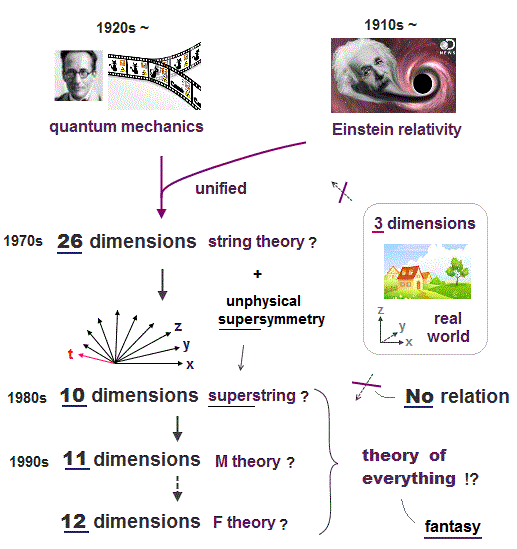
The present only theory of everything allegedly unifying (fantasy) quantum mechanics and Einstein relativity is string theory or M theory which requires unrealistic 10 or 11 dimensional spacetime.
These fictitious extra-dimensional mainstream physics claims that gravity is caused by (virtual) gravitons which must move faster than light ( this lower ), which contradicts Einstein relativity, in order to escape from the black hole into outer space.
↑ So these self-contradictory gravitons are unreal, and the cause of gravitational force needs other realistic things.
(Fig.19) Field "imbalance" and their oscillation cause macroscopic gravity.
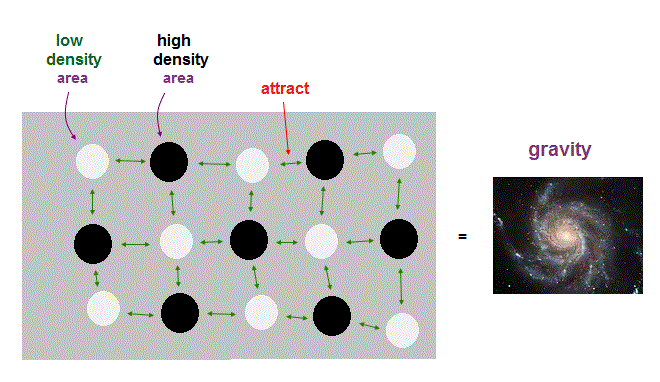
It is known that gravity is extremely weaker (= about 10-39 times Coulomb force ! ) than other fundamental forces. So it is natural to think gravity is NOT fundamental force but some macroscopic effect of other forces.
We can explain the Coulomb mechanism using "field density" imbalance.
Basically, "field" tends to be uniform in pressure, so high and low pressure regions attract each other.
We can think gravity as large-scale imbalance in field's density (= medium filling all space ). If there are higher (= denser ) pressure areas, they tend to approach lower pressure areas.
When a large number of the same kind of field attraction synchronize, it generates "gravity", as macroscopic effect. This idea is more natural than other "fantasy" 10 dimensions and graviton.

Feel free to link to this site.